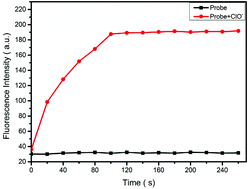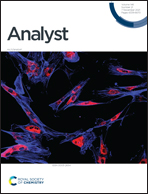A long-wavelength activable AIEgen fluorescent probe for HClO and cell apoptosis imaging†
Abstract
Hypochlorous acid (HClO) is an important bactericide, and adjusting the content of HClO helps to improve the host's innate immunity and resist microbial invasion. Aggregation-induced luminescence (AIE) is the opposite of aggregation-induced quenching (ACQ). Compounds with AIE properties emit weakly in a dispersed state in solution and they can emit strong fluorescence in an aggregated state. In this article, we proposed a new AIE fluorescent probe QM-ClO based on the quinoline-malononitrile (QM) fluorophore and dimethylthiocarbamate (DMTC) to detect HClO. The probe QM-ClO showed a fast response time, a low detection limit of 30.8 nM and a large Stokes shift (190 nm). Carbonyl cyanide metachlorophenyl-hydrazone (CCCP) was used to induce cell apoptosis, and then an increase in the HClO content was observed in the cell. It is proved that cell apoptosis can lead to the increase of the HClO content in the cell. This probe provides an effective tool for studying apoptosis-related diseases.



 Please wait while we load your content...
Please wait while we load your content...